
Zg480. Naval Construction Battalion 115 lands at Subic Bay, the 8th of Feb. 1945.
————————————————————————————-
115 Naval Construction Battalion, 1943-1945
This is the 115 Naval Construction Battalion, 1943-1945 Unit Book during WWII. They also served in Subic Bay, hence my interest!
This book is published by and for the men of the 115th Battalion. Photos other than those credited are by Battalion Photographers H. S. Zimmerman and E. F. Heil. Art Work- P. T. LaTerra. Copy- R. W. Wolfe. Planning- H. S. Zimmerman.
Printed by Edward Stern & Company, Philadelphia, Pennsylvania.
This book is held now by the Naval History and Heritage Command and I posted a complete copy at this URL, click here:
For this presentation I copied only text and images that pertain to Subic Bay.
————————————————————————————
Naval Construction Battalion 115 is under way to the Philippines and lands at Lingayen Gulf with Gen MacArthur. It handles a few projects there and then lands at Subic Bay on the 8th of Feb. 1945. This first presentation of 7 images is of the NCB 115’s landing and projects at Lingayen Gulf. These pictures interest me personally because they show the US Navy Amphibious Force. It calls itself the “Gator Navy” and I was a “Gator Sailor” for 6 years on gator ships LSD-2 USS Belle Grove and LSD-30 USS Fort Snelling.

Zg481. Naval Construction Battalion 115 is on its way to the Philippines in 1945.

Zg482. Naval Construction Battalion 115 is loaded on amphibious ships, on its way to the Philippines in 1945, to land in Lingayen Gulf with Gen. MacArthur. This picture got my interest because it seems the Seabees rigged their trucks with double decks, 2nd deck, to load more cargo; first time I saw that.

Zg483. The NCB 115 is landing in Lingayen Gulf, January 1945.

Zg484. The NCB 115 is landing in Lingayen Gulf, January 1945.

Zg485. The NCB 115 is landing in Lingayen Gulf, January 1945.

Zg486. The NCB 115 is landing in Lingayen Gulf, January 1945.

Zg487. The NCB 115 completes projects at Lingayen Gulf, January 1945 and is welcomed by the Filipinos.

Zg488. The NCB 115 completes projects at Lingayen Gulf, January 1945 and is welcomed by the Filipinos.
======================================
Second Segment.
115 Naval Construction Battalion, 1943-1945
First impressions from Olongapo February 1945.
This is the 115 Naval Construction Battalion, 1943-1945 Unit Book during WWII. They also served in Subic Bay, hence my interest!
This book is published by and for the men of the 115th Battalion. Photos other than those credited are by Battalion Photographers H. S. Zimmerman and E. F. Heil. Art Work- P. T. LaTerra. Copy- R. W. Wolfe. Planning- H. S. Zimmerman.
Printed by Edward Stern & Company, Philadelphia, Pennsylvania.
This book is held now by the Naval History and Heritage Command and I posted a complete copy at this URL, click here:
For this presentation I copied only text and images that pertain to Subic Bay.
This 2nd Segment has 13 images and shows 13 images of the first impressions of Olongapo in Subic Bay in February 1945.
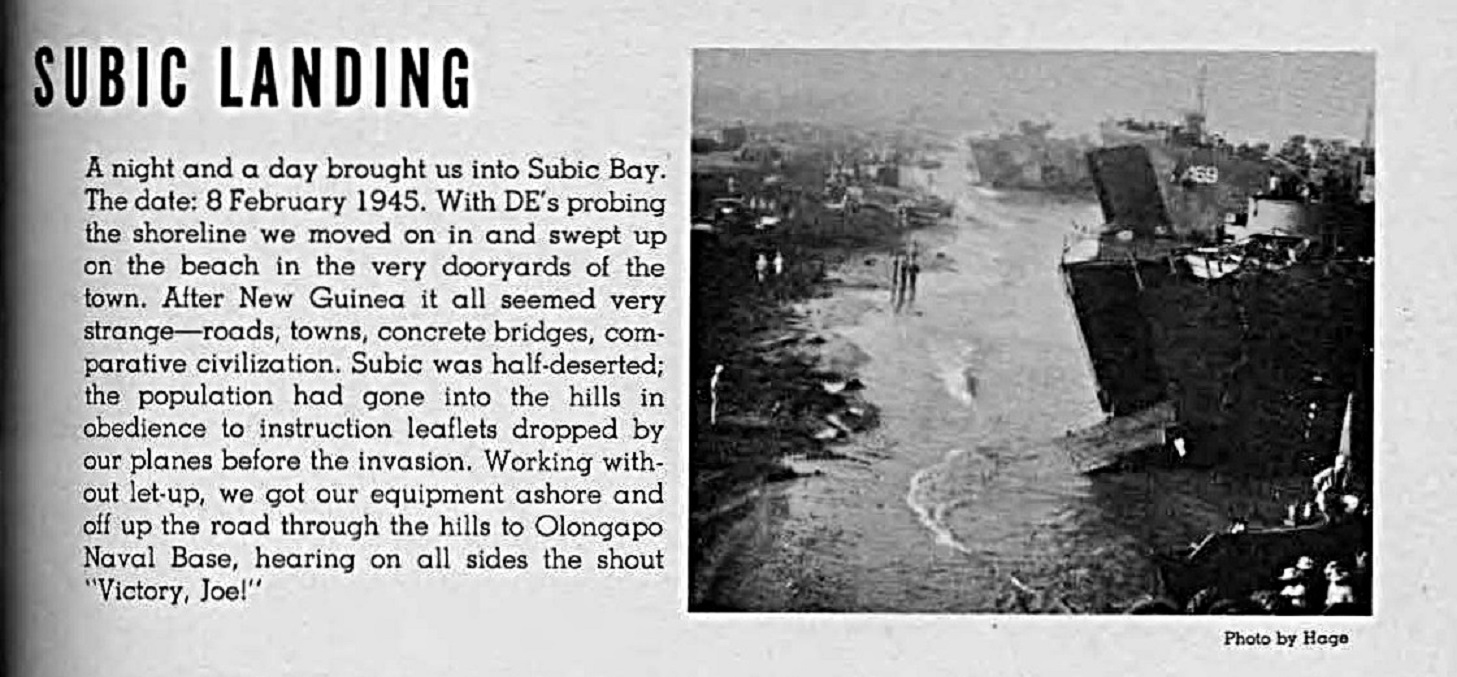
Zg489, NCB-115, S.B. 1945. Naval Construction Battalion 115 arrived in Olongapo, Subic Bay on the 8th of February 1945.

Zg490, NCB-115, S.B. 1945. Naval Construction Battalion 115 arrived in Olongapo, debarking in Subic Bay, with DE’s probing the shoreline we moved on in and swept up on the beach in the very dooryards of the town.

Zg491, NCB-115, S.B. 1945. Naval Construction Battalion 115 arrived in Olongapo, debarking in Subic Bay. Working without let-up, we got our equipment ashore and off up the rood through the hills to Olongapo Naval Bose, hearing on all sides the shout “Victory, Joe!”

Zg492, NCB-115, S.B. 1945. Naval Construction Battalion 115 arrived in Olongapo, debarking in Subic Bay. Wow, that looks like one of the LST bow doors. Working without let-up, we got our equipment ashore and off up the rood through the hills to Olongapo Naval Bose, hearing on all sides the shout “Victory, Joe!”

Zg493, NCB-115, S.B. 1945. Naval Construction Battalion 115 arrived in Olongapo, debarking in Subic Bay. To me that looks like a Bunker used by the Japanese. Working without let-up, we got our equipment ashore and off up the rood through the hills to Olongapo Naval Bose, hearing on all sides the shout “Victory, Joe!”

Zg494, NCB-115, S.B. 1945. Naval Construction Battalion 115 arrived in Olongapo. Olongapo showed all the ravages of war. Much of the town had been bombed or burned. Standing among the great trees were 155 mm. howitzers, ‘Long Toms” and tanks.

Zg495, NCB-115, S.B. 1945. Naval Construction Battalion 115 arrived in Olongapo, Subic Bay on the 8th of February 1945. Intrepid Seabees went hunting up at the front- for souvenirs.”Any souvenirs around here, mate”?

Zg496, NCB-115, S.B. 1945. Naval Construction Battalion 115 arrived in Olongapo, Subic Bay on the 8th of February 1945. –OLONGAPO CAMP: What a place to sleep! Scattered around the field where we pitched our pup tents, field artillery rocked the ground and shattered the night as it shelled Zig Zag Pass. From across the road 155’s lumbered overhead. Machine gun and rifle fire punctuated the occasional silences. Nevertheless, sleep we did-fully clothed, loaded rifles beside us.

Zg497, NCB-115, S.B. 1945. Naval Construction Battalion 115 arrived in Olongapo, Subic Bay on the 8th of February 1945. –OLONGAPO CAMP: Chow from our field kitchen was eaten anywhere; on boxes, the ground or standing. Hungry civilian children, cans in hand, eagerly accepted any leavings.

Zg498, NCB-115, S.B. 1945. Naval Construction Battalion 115 arrived in Olongapo, Subic Bay on the 8th of February 1945. –OLONGAPO CAMP: Chow from our field kitchen was eaten anywhere; on boxes, the ground or standing.

Zg499, NCB-115, S.B. 1945. Naval Construction Battalion 115 arrived in Olongapo, Subic Bay on the 8th of February 1945. –OLONGAPO CAMP: Chow from our field kitchen was eaten anywhere; on boxes, the ground or standing.

Zg500, NCB-115, S.B. 1945. Naval Construction Battalion 115 arrived in Olongapo, Subic Bay on the 8th of February 1945. –OLONGAPO CAMP: Chow from our field kitchen was eaten anywhere; on boxes, the ground or standing. Hungry civilian children, cans in hand, eagerly accepted any leavings.

Zg501, NCB-115, S.B. 1945. Naval Construction Battalion 115 arrived in Olongapo, Subic Bay on the 8th of February 1945. –OLONGAPO CAMP: Fire hydrants provided temporary showers. Strangely, neither we nor the laundresses seemed embarrassed at our state of undress.
======================================
Third Segment.
Naval Construction Battalion-115, 1943-1945
Work starts in war ravaged Olongapo and Olongapo Naval Station in February 1945.
The Naval Station Olongapo is being developed now into the Naval Advanced Base Unit—6 (NABU)
This is the Naval Construction Battalion-115, 1943-1945 Unit Book during WWII. They also served in Subic Bay, hence my interest!
This book is published by and for the men of the 115th Battalion. Photos other than those credited are by Battalion Photographers H. S. Zimmerman and E. F. Heil. Art Work- P. T. LaTerra. Copy- R. W. Wolfe. Planning- H. S. Zimmerman.
Printed by Edward Stern & Company, Philadelphia, Pennsylvania.
This book is held now by the Naval History and Heritage Command and I posted a complete copy at this URL:
For this presentation I copied only text and images that pertain to Subic Bay.
This 3rd Segment has 21 images and shows some images of the condition of Olongapo and the former Olongapo Naval Station.

Zg503, NCB-115, Subic Bay 1945.

Zg504, NCB-115, Subic Bay 1945. I believe the building at right is from the Spanish times and stills stands today in the former Ship Repair Activity (SRF), my last duty station 1989-91.

Zg505, NCB-115, Subic Bay 1945.

Zg506, NCB-115, Subic Bay 1945.

Zg507, NCB-115, Subic Bay 1945. In the image at right, where the coal loading structure stands, is now, today, the place of a popular maritime restaurant called Vascos and the museum section is referred to as Magellan. The ridge line in back became the Cubi Point Naval Air Station in the 1950, also built by the Seabees!

Zg508, NCB-115, Subic Bay 1945.

Zg509, NCB-115, Subic Bay 1945.

Zg510, NCB-115, Subic Bay 1945.

Zg511, NCB-115, Subic Bay 1945.

Zg512, NCB-115, Subic Bay 1945.
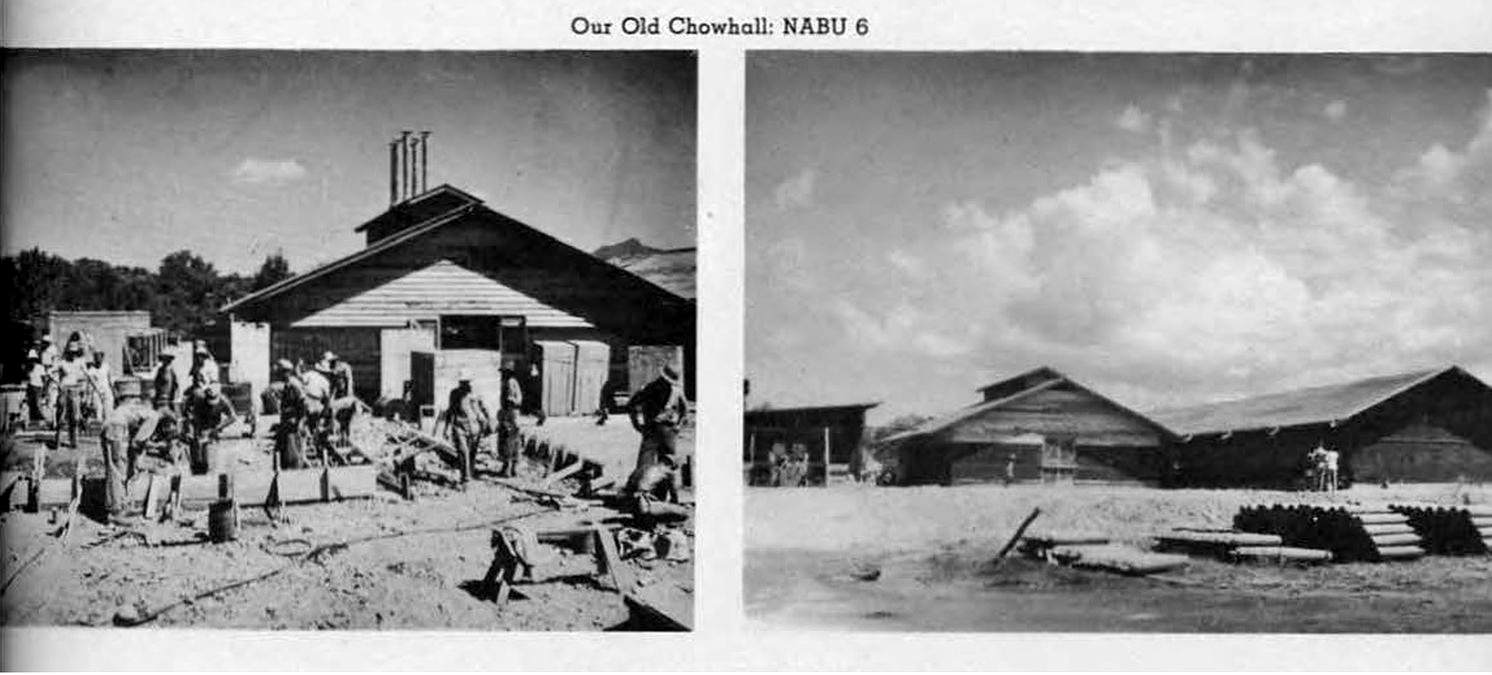
Zg513, NCB-115, Subic Bay 1945.

Zg514, NCB-115, Subic Bay 1945.

Zg515, NCB-115, Subic Bay 1945.

Zg516, NCB-115, Subic Bay 1945.
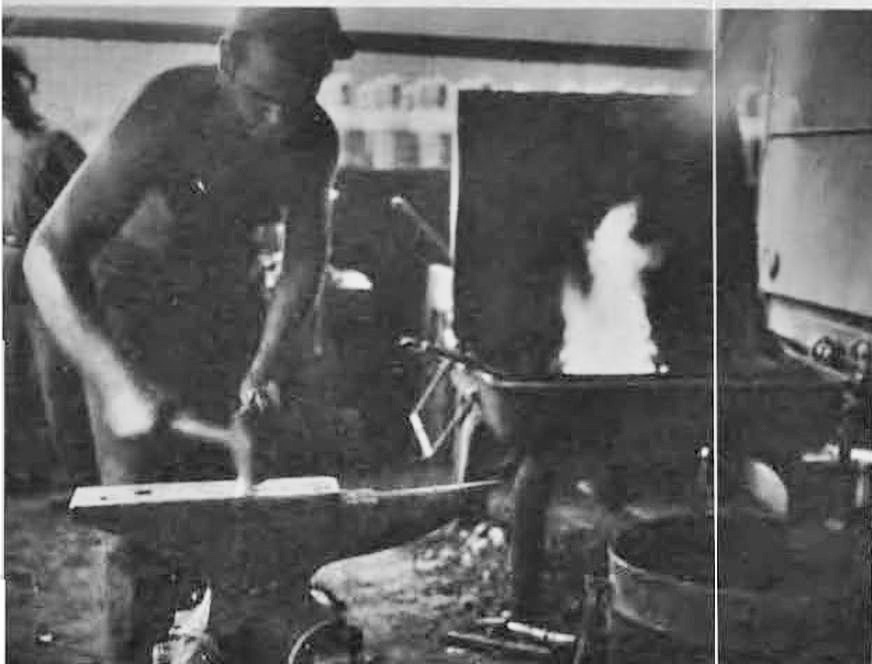
Zg517, NCB-115, Subic Bay 1945.
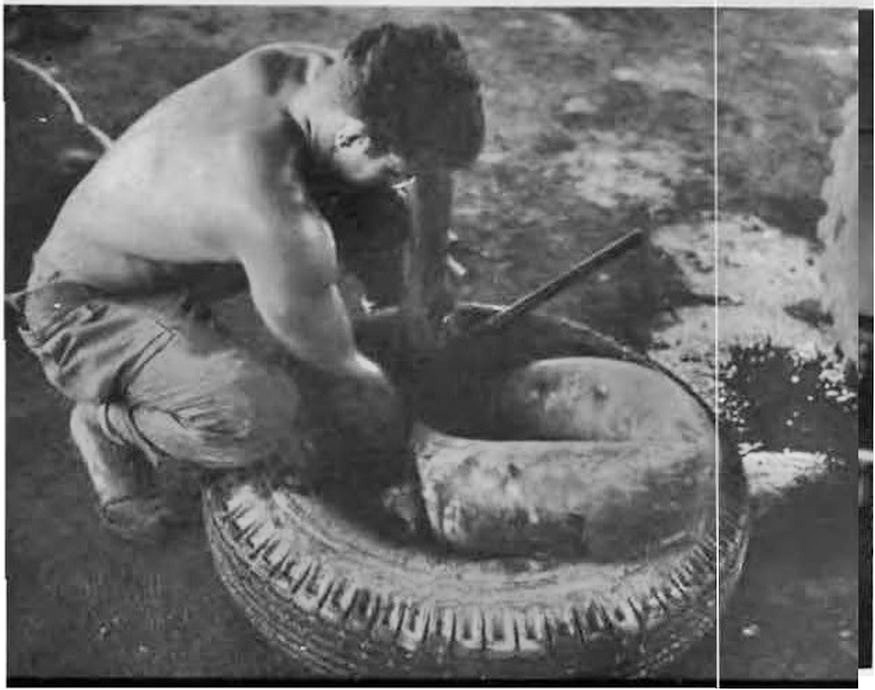
Zg518, NCB-115, Subic Bay 1945.

Zg519, NCB-115, Subic Bay 1945.
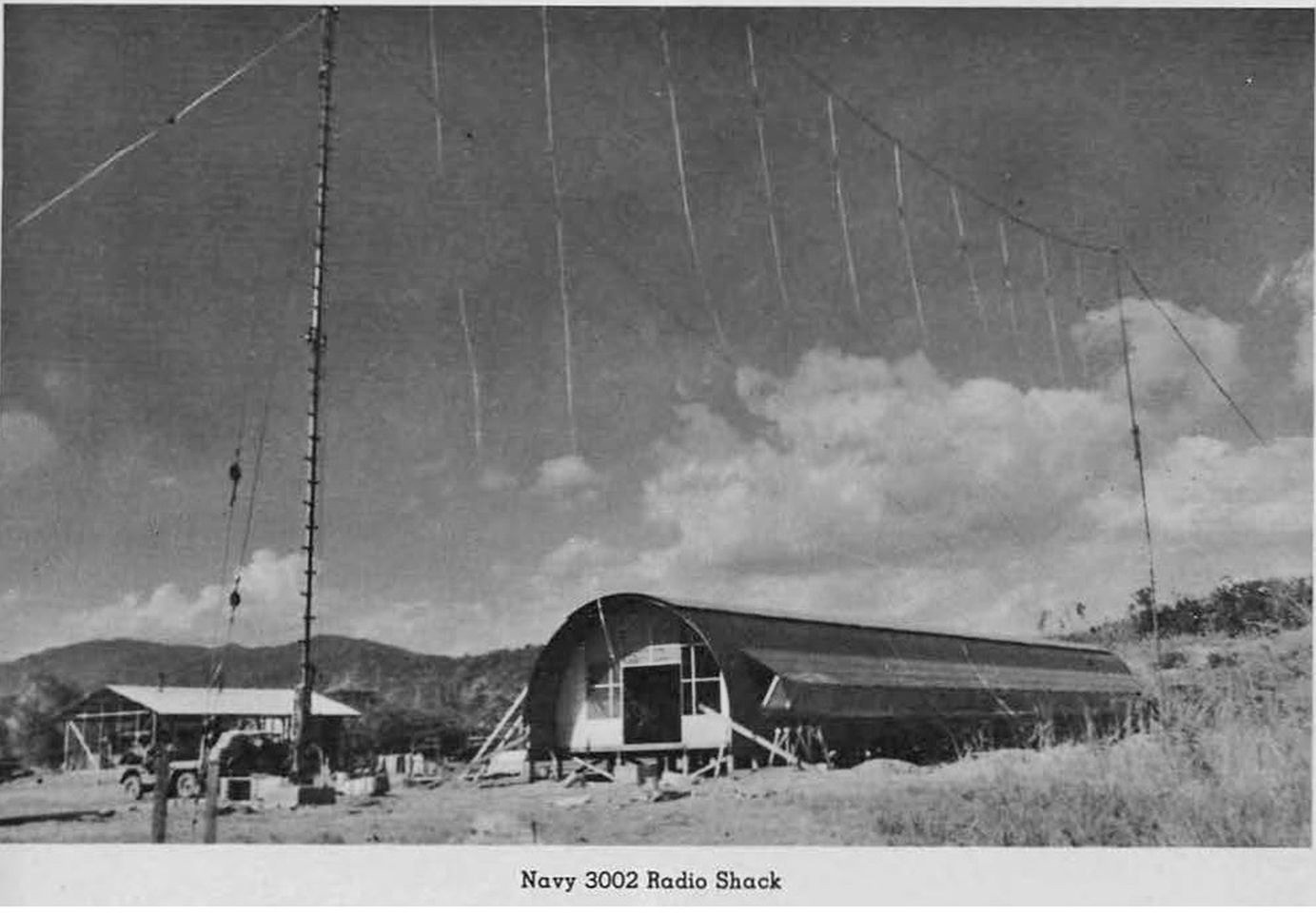
Zg520, NCB-115, Subic Bay 1945.

Zg521, NCB-115, Subic Bay 1945.

Zg522, NCB-115, Subic Bay 1945.

Zg523, NCB-115, Subic Bay 1945.
======================================
Fourth Segment.
Naval Construction Battalion-115, 1943-1945
Some of the first big jobs start in war ravaged Olongapo and Olongapo Naval Station in February 1945.
The Naval Station Olongapo is being developed now into the Naval Advanced Base Unit—6 (NABU)
This is the Naval Construction Battalion-115, 1943-1945 Unit Book during WWII. They also served in Subic Bay, hence my interest!
This book is published by and for the men of the 115th Battalion. Photos other than those credited are by Battalion Photographers H. S. Zimmerman and E. F. Heil. Art Work- P. T. LaTerra. Copy- R. W. Wolfe. Planning- H. S. Zimmerman.
Printed by Edward Stern & Company, Philadelphia, Pennsylvania.
This book is held now by the Naval History and Heritage Command and I posted a complete copy at this URL, click here:
For this presentation I copied only text and images that pertain to Subic Bay.
This 4th Segment has 16 images and shows some images of the condition of Olongapo, the former Olongapo Naval Station and the many jobs started.

Zg524, NCB-115, Subic Bay 1945. That certainly looks like the Kalaklan Point and Bridge area.

Zg525, NCB-115, Subic Bay 1945. Bajac Bajac Brldqe: Manila Road.

Zg526, NCB-115, Subic Bay 1945.

Zg527, NCB-115, Subic Bay 1945. Small boat pier for the Fleet Officer’s Club. I’m familiar with that view, we are looking to the north end of Subic Bay and that is the two hills west of Subic Town proper.
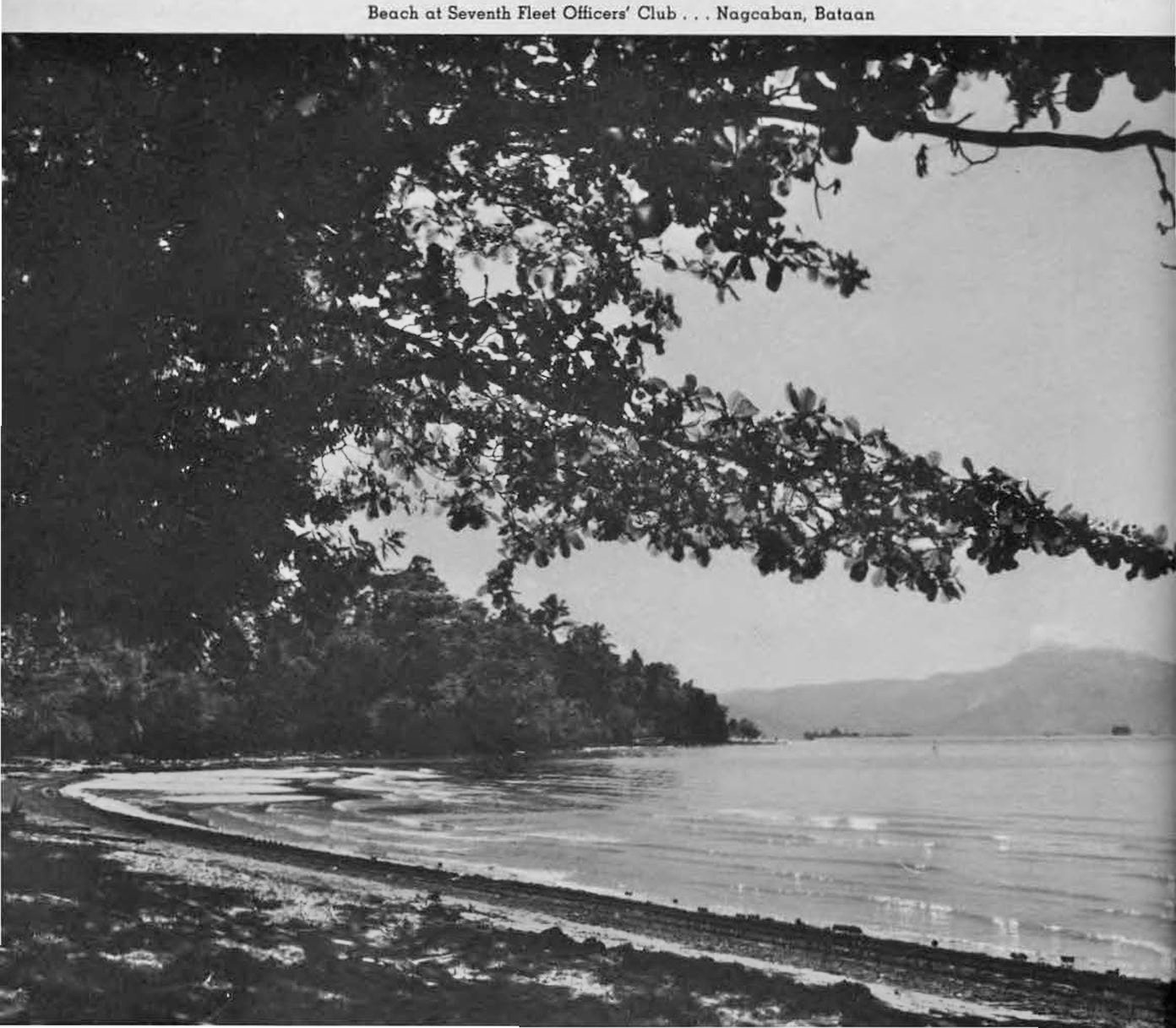
Zg528, NCB-115, Subic Bay 1945. Beach at the Nagcaban Point, site of the Fleet Officer’s Club. This area changed completely in the 1950s when it became part of the Cubi Point Naval Air Station.

Zg529, NCB-115, Subic Bay 1945. An early map that shows Nagcaban Point, Cubi Point, the Olongapo Port and many other geographic names we are familiar with now.

Zg530, NCB-115, Subic Bay 1945. The Fleet Officer’s Club for the 7th Fleet.

Zg531, NCB-115, Subic Bay 1945. The Fleet Officer’s Club for the 7th Fleet in process of construction.

Zg532, NCB-115, Subic Bay 1945. The Fleet Officer’s Club was built across the bay on Bataan peninsula. This will be the Senior Officer Wing.

Zg533, NCB-115, Subic Bay 1945. The Fleet Officer’s Club was built across the bay on Bataan peninsula. This is the Senior Officer Wing Lounge.

Zg534, NCB-115, Subic Bay 1945. The Fleet Officer’s Club. Across the bay on Bataan peninsula laid the Seventh Fleet Officers’ Club. About 20 of our men engaged in and directed its building by Filipino craftsmen. Work began in the middle of March to continue indefinitely. Native materials were used throughout. This is the Junior Officers’ Wing.

Zg535, NCB-115, Subic Bay 1945. Grande Island! Once a coastal artillery emplacement, Grande Island become o Fleet Recreation Area for some 3000 daily of the men who served on cruisers, battleships, DD’s and DE’s.

Zg536, NCB-115, Subic Bay 1945. Grande Island!

Zg537, NCB-115, Subic Bay 1945. Grande Island! I don’t know what has happened to this building, but I believe it is on the north shore because I believe I know that peak, right and next to it.

Zg538, NCB-115, Subic Bay 1945. Grande Island, Battery Warwick! Battery Warwick is still there, the guns are gone, (2 Six Inch are left) that communication tower is gone now, but the Battery Warwick compound is fenced in, locked up and used for radar purpose for the Subic International Airport, the ex Cubi Point Naval Air Station.

Zg539, NCB-115, Subic Bay 1945. We know where Kalaklan Point is; on the map in this segment it is still spelled Calaclan Point. That tower is gone and is replaced by a new Navigation Light. ATC stands for Amphibious Training Center and I believe it was located between Baloy Long Beach to the Calapacuan Village area; I have not nailed down the exact spot yet.
======================================
Fifth Segment.
Naval Construction Battalion-115, 1943-1945
The Fifth Segment Covers:
The birth of the Naval Supply Depot (DSD) at today’s Barrio Barretto (the Prewar Rifle Range), which was also the Pontoon assembly area and which in addition furnished the piers for NSD. Notice the 1945 model “Honey Barge”.
Halfmoon Beach was the small craft repair area; I bet the Navy had divers there.
The Sawmill is mentioned and all the furniture that had to be produced.
The Naval Station Olongapo is being developed now into the Naval Advanced Base Unit—6 (NABU); that is where Olongapo was and what became the Naval Station Subic Bay, later the Naval Base.
Another big job was the Amphibious Training Command, (ATC); at this point all attention was directed at the last step to end the war, “Invasion of Japan”. I added a map and indicated where I believe it was located, at the present Barrio Matain.
This is the Naval Construction Battalion-115, 1943-1945 Unit Book during WWII. They also served in Subic Bay, hence my interest!
This book is published by and for the men of the 115th Battalion. Photos other than those credited are by Battalion Photographers H. S. Zimmerman and E. F. Heil. Art Work- P. T. LaTerra. Copy- R. W. Wolfe. Planning- H. S. Zimmerman.
Printed by Edward Stern & Company, Philadelphia, Pennsylvania.
This book is held now by the Naval History and Heritage Command and I posted a complete copy at this URL, click here:
For this presentation I copied only text and images that pertain to Subic Bay.
This 5th Segment has 17 images and shows some images of the jobs mentioned above.
Hint: The next Segment will be Olongapo 1945!

Zg540, NCB-115, Subic Bay 1945. NSD 1945 in Subic Bay at the former Maquinaya Rifle Range, now known as Barrio Barretto in Olongapo City.

Zg541, NCB-115, Subic Bay 1945. NSD 1945 in Subic Bay at the former Maquinaya Rifle Range, today, my house stands somewhere to the left.

Zg542, NCB-115, Subic Bay 1945. NSD 1945 in Subic Bay at the former Maquinaya Rifle Range, now known as Barrio Barretto in Olongapo City.
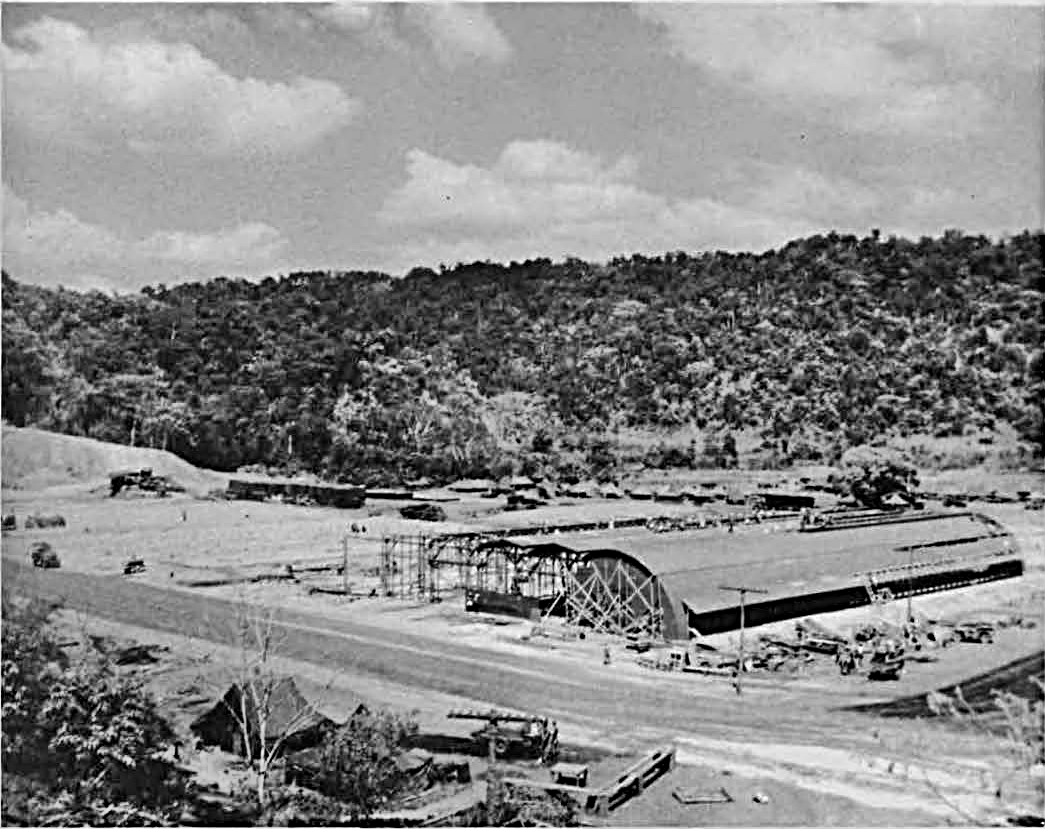
Zg543, NCB-115, Subic Bay 1945. NSD 1945 in Subic Bay at the former Maquinaya Rifle Range, now known as Barrio Barretto in Olongapo City.

Zg544, NCB-115, Subic Bay 1945. NSD 1945 in Subic Bay at the former Maquinaya Rifle Range, now known as Barrio Barretto in Olongapo City.

Zg545, NCB-115, Subic Bay 1945. NSD 1945 in Subic Bay at the former Maquinaya Rifle Range, now known as Barrio Barretto in Olongapo City.

Zg545a, NCB-115, Subic Bay 1945. NSD 1945 in Subic Bay at the former Maquinaya Rifle Range, now known as Barrio Barretto in Olongapo City.

Zg546, NCB-115, Subic Bay 1945. Pontoons, as a Gator Sailor, I know a lot about pontoons. My Diving Barge in Da Nang Viet Nam was built of pontoons and it was my home on pontoon for a year. The assembly area of the pontoons was also located at the former Naval Maquinaya Rifle Range, now called Barrio Barretto. I love that Navy term “Honey Barge”, anyone like to guess what they for?

Zg547, NCB-115, Subic Bay 1945. More pontoons, the assembly area of the pontoons was also located at the former Naval Maquinaya Rifle Range, now called Barrio Barretto.

Zg548, NCB-115, Subic Bay 1945. More pontoons, the assembly area of the pontoons was also located at the former Naval Maquinaya Rifle Range, now called Barrio Barretto.

Zg549, NCB-115, Subic Bay 1945. Amphibious Training Command (ATC).

Zg550, NCB-115, Subic Bay 1945. Amphibious Training Command (ATC). Where was it located? I see Grande Island, the former Fort Wint and at right Cinco Picos Mountain.

Zg551, NCB-115, Subic Bay 1945. Amphibious Training Command (ATC). I don’t know where it was but this is my estimated location based on descriptions and the pictures of NCB 115.

Zg552, NCB-115, Subic Bay 1945. Amphibious Training Command (ATC). We were proud of our accomplishment for in less than a month we had built a small town. Added to this was the knowledge that there would be no delay occasioned by us in training troops for the corning invasion of Japan.

Zg553, NCB-115, Subic Bay 1945. Amphibious Training Command (ATC). We were proud of our accomplishment for in less than a month we had built a small town. Added to this was the knowledge that there would be no delay occasioned by us in training troops for the corning invasion of Japan.

Zg554, NCB-115, Subic Bay 1945. Amphibious Training Command (ATC). ATC was intended to house and train key personnel for three divisions at a time. After the Japanese surrender it became a 5000-man capacity receiving station.

Zg555, NCB-115, Subic Bay 1945. Furniture Factory. Chairs, desks, lounge, camp and school . . . tables, mess, serving, tailor’s, map … desks, ordinary, typing and radio … cabinets, filing, linen, storage and supply, kitchen, mess . . . everything in wood from surveyor’s stokes to rowboats and truck bodies is to be found in the catalog of products from the 115th’s furniture shop. Twenty-two Seabee and Filipino cabinet-makers, on average, produced the furnishings for ATC., NSD,, NABU, 24th Regiment, Base BOQ and all the other activities of the entire Subic area.

Zg556, NCB-115, Subic Bay 1945. Half Moon Beach. Between ATC and Olongapo lay Half-Moon Beach, the shore lined with LCM’s and other small landing-crafts. The unit working there was the small-boot repair activity. That is what I was attached to in I Corps Viet Nam as a diver for a year. We repaired all underwater fuel lines, repaired underwater all kinds of boats and ships. salvaged all kinds of things that sunk in rivers or the oceans such as aircrafts or people, boats or ships, one big job was a LST in Cua Viet, just under the DMZ.
======================================
Sixth Segment.
Naval Construction Battalion-115, 1943-1945
The Sixth Segment is about freshly liberated Olongapo and its community coming back to life in 1945:
This is the Naval Construction Battalion-115, 1943-1945 Unit Book during WWII. They also served in Subic Bay, hence my interest!
This book is published by and for the men of the 115th Battalion. Photos other than those credited are by Battalion Photographers H. S. Zimmerman and E. F. Heil. Art Work- P. T. LaTerra. Copy- R. W. Wolfe. Planning- H. S. Zimmerman.
Printed by Edward Stern & Company, Philadelphia, Pennsylvania.
This book is held now by the Naval History and Heritage Command and I posted a complete copy at this URL, click here:
For this presentation I copied only text and images that pertain to Subic Bay.
This 6th Segment has 20 images of the freshly liberated Olongapo and its community coming back to life in 1945:

Zg557, NCB-115, Olongapo, Subic Bay 1945. During the years of enemy occupation Olongapo degenerated from a neat provincial town to a clutter of decrepit buildings whose peeling paint and patchwork repairs showed the “benefits” of the “Greater East Asia Co Prosperity Sphere.”

Zg558, NCB-115, Olongapo, Subic Bay 1945. Across Subic Bay, left of center in Mt Redondo.
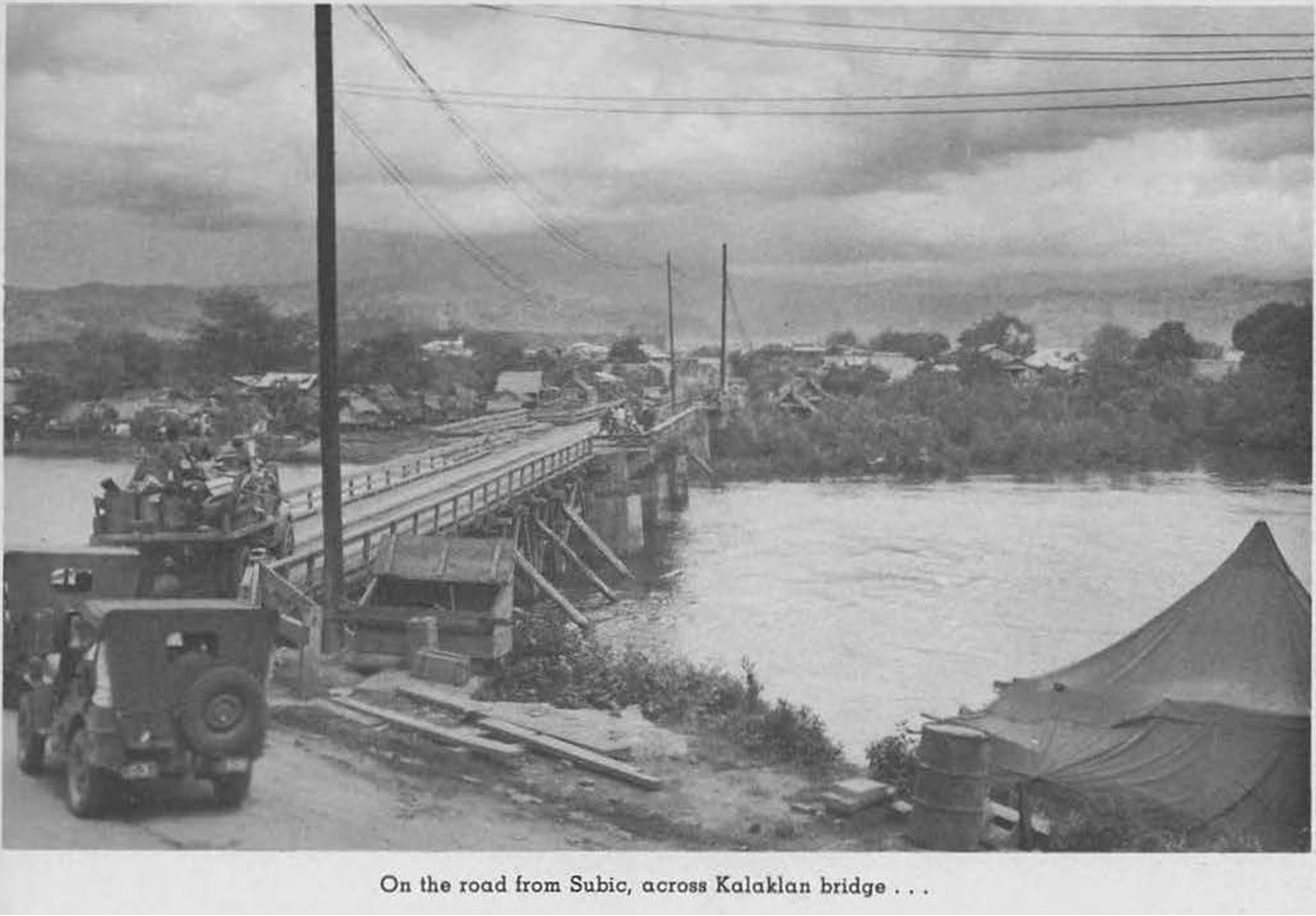
Zg559, NCB-115, Olongapo, Subic Bay 1945. The Kalaklan Bridge, it looks like it had concrete pilings or bases since before the war.

Zg560, NCB-115, Olongapo, Subic Bay 1945. I assume this is Dewey Ave. and we are looking from the Kalaklan Bridge.

Zg561, NCB-115, Olongapo, Subic Bay 1945. During the years of enemy occupation Olongapo degenerated from a neat provincial town to a clutter of decrepit buildings whose peeling paint and patchwork repairs showed the “benefits” of the “Greater East Asia Co Prosperity Sphere.”

Zg562, NCB-115, Olongapo, Subic Bay 1945. During the years of enemy occupation Olongapo degenerated from a neat provincial town to a clutter of decrepit buildings whose peeling paint and patchwork repairs showed the “benefits” of the “Greater East Asia Co Prosperity Sphere.”

Zg563, NCB-115, Olongapo, Subic Bay 1945. The Aeta, as they are locally called, do have a good size community, at the eastern edge on the greater former Naval Base, the Subic Bay Freeport Zone (SBFZ) now.

Zg564, NCB-115, Olongapo, Subic Bay 1945. Life in Olongapo in 1945.

Zg565, NCB-115, Olongapo, Subic Bay 1945. Wow, they already called it City Hall then; Olongapo didn’t become a city until a few years later.

Zg566, NCB-115, Olongapo, Subic Bay 1945. Laundry! On our first day al Olongapo boys. girls and women come among our tents seeking laundry lo do. From that lime on one of our greatest chores was forgotten.

Zg567, NCB-115, Olongapo, Subic Bay 1945. Laundry! After we moved to Santa Rita the laundry girls gathered along the fence in their prettiest dresses to deliver finished work and to drum up business. On our side, one of the favorite evening pastimes was to sit and observe the proceedings, now and then yelling “magandang dalaga” or other choice Tagalog expression.

Zg568, NCB-115, Olongapo, Subic Bay 1945. To Market to Market!

Zg569, NCB-115, Olongapo, Subic Bay 1945. To Market to Market! Camotes, mangos, papaya, bananas, and chickens, shoes-all manner of things usable and edible were to be found in the village markets and roadside stands.

Zg570, NCB-115, Olongapo, Subic Bay 1945. Education! We were astonished at their thorough knowledge of American history. From the youngest to the oldest the students were eager to return to their long interrupted studies, to them a prized possession.
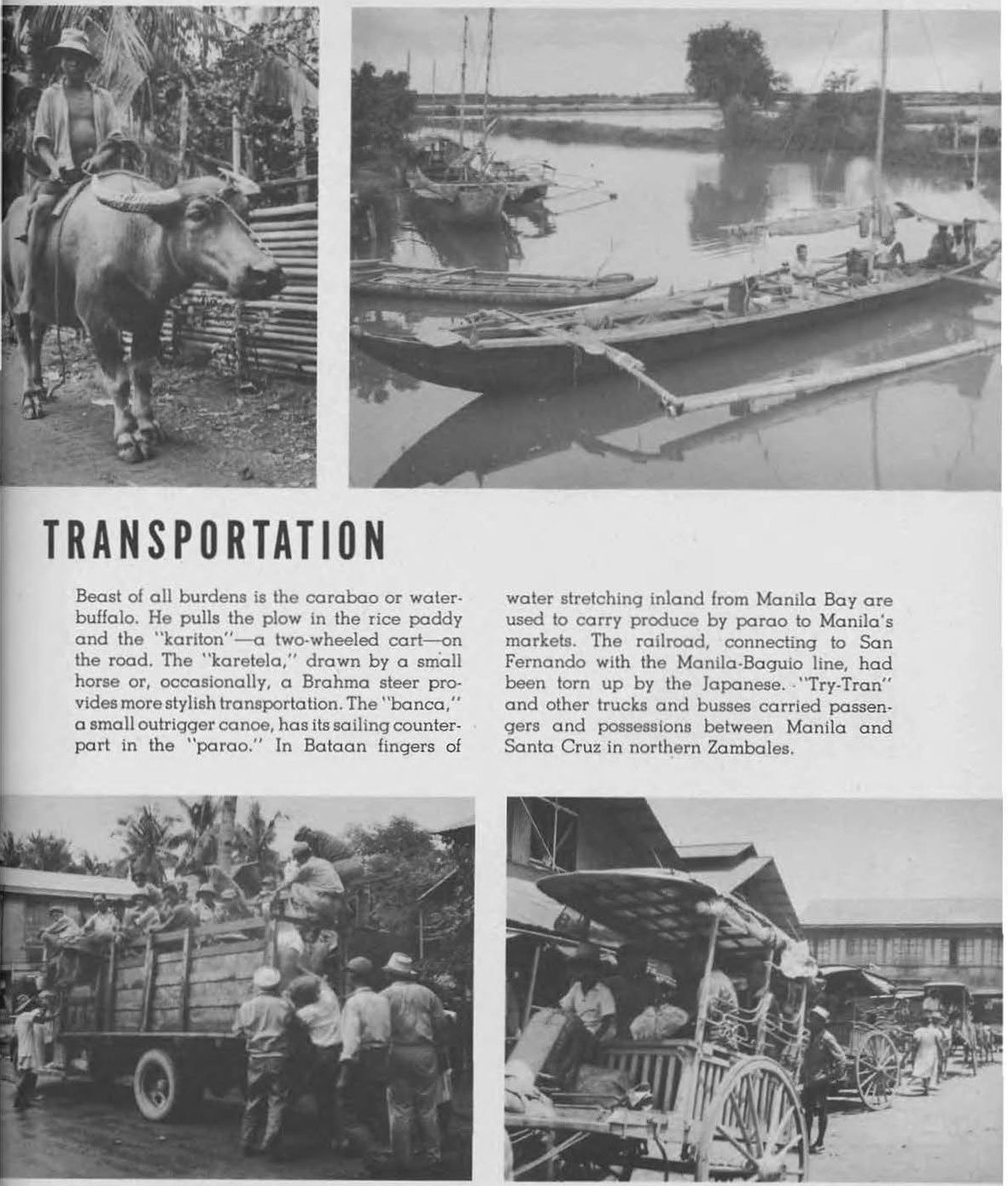
Zg571, NCB-115, Olongapo, Subic Bay 1945. Transportation in 1945.

Zg572, NCB-115, Olongapo, Subic Bay 1945. Life in Olongapo in 1945.

Zg573, NCB-115, Olongapo, Subic Bay 1945. Life in Olongapo in 1945.

Zg574, NCB-115, Olongapo, Subic Bay 1945. Filipinos are a friendly, laughing people. They like and admire Americans. In this, the girls are no exception,

Zg575, NCB-115, Philippines 1945. The daughters of Philippines Supreme Court Justice Pablo: Glorio, Rosario, Victoria, Mini, Lena … in formal dress.

Zg576, NCB-115, Olongapo, Subic Bay 1945. ASINAN! The Japanese invasion of Luzon in late 1941 resulted in the burning of Olongapo; a blow from which the town had only partially recovered when it suffered it again on the oppressor’s withdrawal. The resulting housing shortage was aggravated by the influx of workers needed for the expansion of the Naval Base.
======================================
Seventh and Last Segment.
Naval Construction Battalion-115, 1943-1945
The seventh Segment tells the story of the Battle of the ZigZag Pass, has Memoriam Pages for the troops that gave it all, the building of the Alava Wharf Mammoth Job and various images of life in 1945 of the very busy NCB 115.
This is the Naval Construction Battalion-115, 1943-1945 Unit Book during WWII. They also served in Subic Bay, hence my interest!
This book is published by and for the men of the 115th Battalion. Photos other than those credited are by Battalion Photographers H. S. Zimmerman and E. F. Heil. Art Work- P. T. LaTerra. Copy- R. W. Wolfe. Planning- H. S. Zimmerman.
Printed by Edward Stern & Company, Philadelphia, Pennsylvania.
This book is held now by the Naval History and Heritage Command and I posted a complete copy at this URL, click here:
For this presentation I copied only text and images that pertain to Subic Bay.
This 7th Segment has 18 images of the Navy Installations in Olongapo and its community coming back to life in 1945:

Zg577, NCB-115, Olongapo, Subic Bay 1945. The Battle of the ZIGZAG Pass, to isolate Bataan that the Japanese could not retreat into Bataan like the US Forces did in 1942.

Zg578, NCB-115, Olongapo, Subic Bay 1945. In February 1945 the Eighth Army’s XI Corps, Major-general Charles P. Hall commanding, faced the task of taking the Zig Zag Pass-six miles of twisting, winding road, hairpin turns and blind-angle approaches.

Zg579, NCB-115, Olongapo, Subic Bay 1945. Only after crossing the Santa Rita River did the force meet heavy opposition. From then on it was o job of knocking out the enemy pillbox by pillbox, cave by cove.

Zg580, NCB-115, Olongapo, Subic Bay 1945. Meanwhile. the l49th Regiment Kentucky
Reserves went off through the forests on the north flank to cut around the Japanese, reach Dinalupihan on the plain and then strike the Japanese from the rear. They were led by the Aeta, Negrito scouts.

Zg581, NCB-115, Olongapo, Subic Bay 1945. In Memoriam. Defending our Country is not free; many gave it all and or were wounded.

Zg582, NCB-115, Olongapo, Subic Bay 1945. In Memoriam. Defending our Country is not free; many gave it all and or were wounded.

Zg583, NCB-115, Olongapo, Subic Bay 1945. The Battallion’s Officer Country in Sta Rita Olongapo.

Zg584, NCB-115, Olongapo, Subic Bay 1945. At Santa Rita Comp we at last had our chapel, dedicating it on 16 September 1945. Seating 200 people, it is a beautiful building mode of native lumber, sawale and nipa. The Furniture Shop outdid itself in the matter of the altar. shell lights, pews and other appointments. Here sang the Olongapo Methodist Church choir and another choir was formed for the Catholic services.
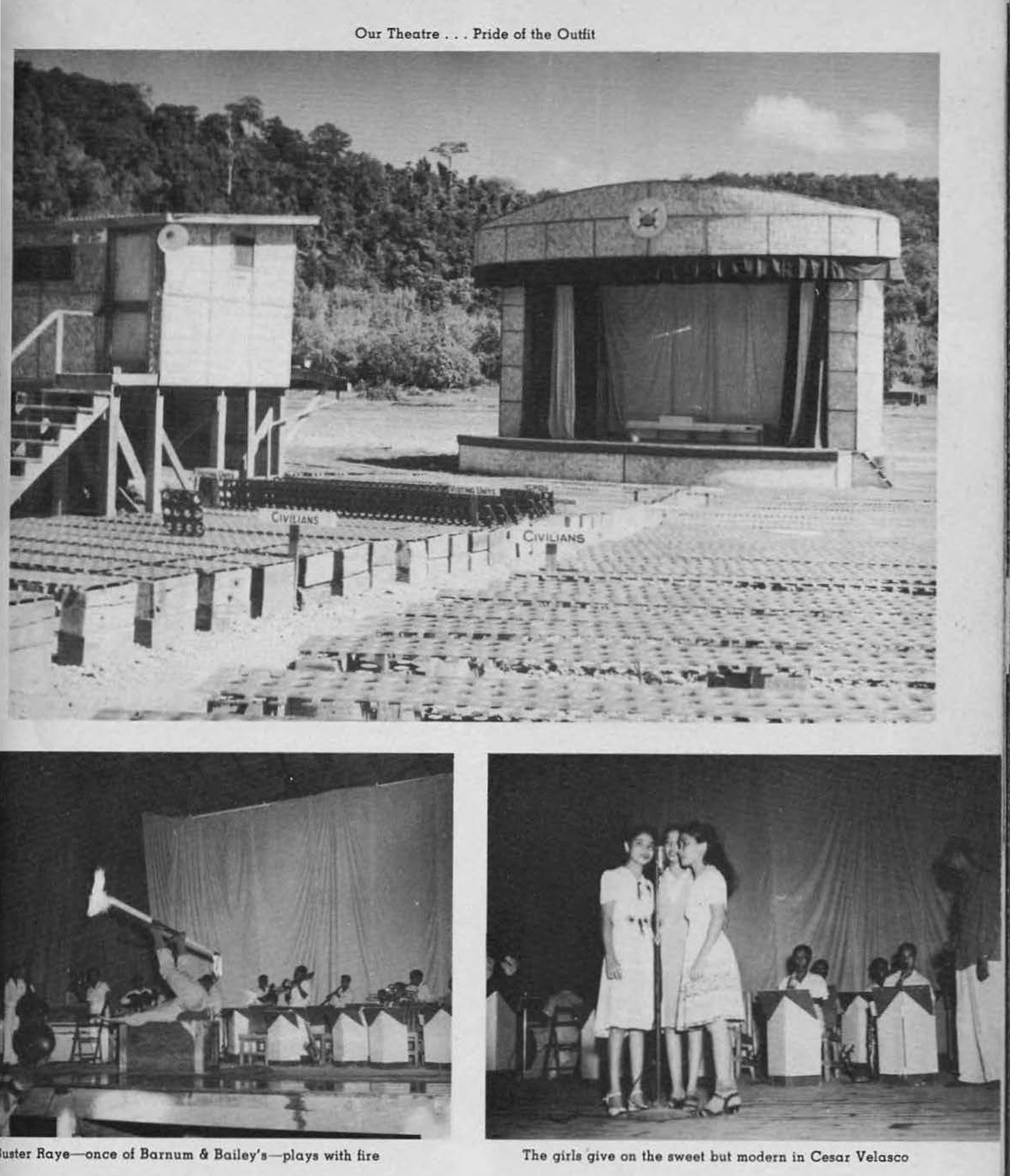
Zg585, NCB-115, Olongapo, Subic Bay 1945. Our theatre, Pride of the Outfit!

Zg586, NCB-115, Olongapo, Subic Bay 1945. After our own theater was completed more
shows come our way. Sponsored by Army Special Services the first of these were Cesar Velosco’s and the Skyroom shows. Acrobats, comedians, singers and good bonds were their features.

Zg587, NCB-115, Olongapo, Subic Bay 1945. After our own theater was completed more
shows come our way. Sponsored by Army Special Services the first of these were Cesar Velosco’s and the Skyroom shows. Acrobats, comedians, singers and good bonds were their features.

Zg588, NCB-115, Olongapo, Subic Bay 1945. Top thriller of sports activity was the game at Manila’s Rizal Stadium. The Bears, billed by local papers as “the New Guinea Champs,” played the 38th Division All-Stars, newspapered as “the New Guinea Army Champs.” Both teams earned such titles in that Sunday afternoon game that was finally called after 13 scoreless innings!

Zg589, NCB-115, Olongapo, Subic Bay 1945. ALAVA DOCK. The prewar Alava Wharf was just large enough to handle the S. S. President Hording.
Note from Karl: On all Subic Bay Naval Base and SBFZ drawings all the piers are called “Wharfs”. During my Navy days, 1960-91 we just called them all “Piers”.

Zg590, NCB-115, Olongapo, Subic Bay 1945. ALAVA DOCK. This picture shows the full length of the prewar seawall of the former Naval Station Olongapo. At the end of that wall, going inland about 100 yards was the location of the infamous tennis court where the Imperial Japanese kept the about 1200 POW survivors of the Oryoku Maru for over a week in Dec. 1944. The POWs were packed in that small place with almost no water, food or medical service!!!!!!!!!!!!!

Zg591, NCB-115, Olongapo, Subic Bay 1945. ALAVA DOCK. The project provided for 1250′ of new
pier 60′ and 40′ in width with two approach piers about 165′ long.
A ship is alongside. The Army had added to the old Alava Wharf, concurrent with landing operations, built a 360′ x 31′ dock there; they had to clear away the ruins before proceeding.

Zg592, NCB-115, Olongapo, Subic Bay 1945. ALAVA DOCK. It was a Mommoth Job, the project started 23 July 1945, and it was one of our larger projects and work continued still in October.

Zg593, NCB-115, Olongapo, Subic Bay 1945. ALAVA DOCK. Three ships are alongside! When completed it could tie up three Victory ships with ease. Over 2000 piles averaging 80′ in length, one
and a half million board feet of heavy timber, 1790 kegs of boat spikes, went into its construction.

Zg594, NCB-115, Olongapo, Subic Bay 1945. ALAVA DOCK. The Alava Wharf is finished later it was made even longer and we called it Alava Extension Wharf. The supplies are moving and the last Japanese invaders will be neutralized!